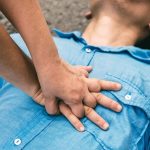 An emergency procedure involving manual compression of the chest overlying the heart and forcing air into the lungs, maintaining circulation when circumstances render the heart unable to pump blood.
An emergency procedure involving manual compression of the chest overlying the heart and forcing air into the lungs, maintaining circulation when circumstances render the heart unable to pump blood.
An emergency procedure consisting of external cardiac massage and artificial respiration.
First-aid measure to aid an individual suffering from lack of oxygen, conscious or unconscious.
A first aid measure to help a victim of heart failure to pump blood to vital organs. It includes the use of artificial resuscitation to force air or oxygen into the lungs and chest pressure to stimulate heartbeat.
An emergency technique to make a person’s heart start beating again. It involves clearing the airways and then alternately pressing on the chest and breathing into the mouth.
A technique that uses chest compressions in addition to artificial respiration to maintain basic life support.
Emergency procedure, consisting of external cardiac massage and artificial respiration, used as the first treatment for a person who has collapsed, is unresponsive, has no pulse, and has stopped breathing. The purpose is to restore blood circulation and prevent death or brain damage due to lack of oxygen. CPR may be performed as a one- or two-person technique. Currently, the American Heart Association recommends that lay people be taught only the one-person method, which involves cardiac compressions at a rate of 80-100 per minute with two artificial breaths interspersed every 15 compressions. As a rule, CPR should not be performed by untrained individuals, though emergency dispatchers nave successfully given instructions over the phone to people at the bedside of cardiac arrest victims. A portion of every CPR class is also dedicated to teaching the treatment of airway obstruction.
An emergency procedure used to save a person’s life when his or her heart and respirations have stopped. The technique involves rhythmic inflation of the lungs alternating with, or accompanied by, simultaneous compressions of the chest over the heart in a specific pattern.
Lifesaving techniques used to maintain oxygen and blood flow to people who are unconscious and whose heart or breathing have stopped. CPR is a combination of rescue breathing, used to maintain oxygen flow to the lungs, and chest compressions, used to maintain blood circulation while awaiting emergency medical assistance.
The restoration of heart output and breathing after cardiac arrest (stopping of the heart) and stopping of breathing. The technique requires artificial respiration and closed-chest cardiac massage. More heroic measures to restore heart function and breathing are employed in hospitals and by trained and equipped emergency medical personnel.
The use of life-saving measures of mouth-to mouth resuscitation and external cardiac compression massage in a person who has collapsed with cardiac arrest. Speedy restoration of the circulation of oxygenated blood to the brain is essential to prevent damage to brain tissues from oxygen starvation. The brain is irreversibly damaged if it is starved of oxygen for more than 4-5 minutes, Someone whose heart has stopped will be very pale or blue-grey (in particular, round the lips) and unresponsive; he or she will not be breathing and will have no pulse. It is important to determine that the collapsed person has not simply fainted before starting CPR. The procedure is described under cardiac/respiratory arrest in appendix 1: basic first aid. In hospital, or when paramedical staff are attending an emergency, CPR may include the use of a defibrillator to apply a controlled electric shock to the heart via the chest wall.
Basic life support. In emergency cardiac care, CPR involves opening the airway, providing artificial breathing, and assisting circulation until definitive treatments can restore spontaneous cardiac, pulmonary, and cerebral function. When trained providers are available, CPR includes defibrillation with automated external defibrillators. In the U.S., the American Heart Association (AHA) develops and disseminates standard techniques for emergency cardiac care.
A life-saving technique that combines rescue breathing and chest compressions.
Clearing air passages to the lungs, giving mouth-to-mouth respiration, and massaging the heart to restore normal breathing after cardiac arrest.
A method of combining chest compressions with rescue breathing to maintain a flow of oxygen-rich blood to the brain while the heart is not working.
Restoring regular respiration after experiencing cardiac arrest involves a series of steps. This comprehensive procedure encompasses the clearance of air passages, the implementation of mouth-to-mouth artificial respiration, and the application of chest compressions to facilitate heart function.
Cardiopulmonary resuscitation (CPR) refers to the application of life-saving techniques to an individual experiencing cardiac arrest, a state in which the heart ceases to pump blood. A person in cardiac arrest exhibits no signs of breathing and does not have a detectable pulse or heartbeat.
The risk of brain damage significantly increases when the brain is deprived of blood and consequently oxygen for a duration exceeding three to four minutes.
In the event of a cardiac arrest, initial intervention involves mouth-to-mouth resuscitation to initiate the casualty’s breathing. If this step proves ineffective, chest compressions using the heel of the hand are performed on the lower part of the breastbone until emergency medical assistance arrives. These measures are applied alternately to reestablish blood circulation to the brain.
